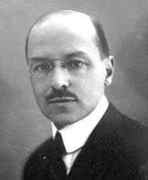Person: Amaldi, Ugo

Ugo Amaldi was an Italian mathematician who worked in the fields of geometry and Lie groups.
Mathematical Profile (Excerpt):
- It was in Pavia that Amaldi completed his secondary school studies at the high school "Ugo Foscolo".
- Felice Casorati had been a pupil at this school forty years before Amaldi.
- At this school Amaldi was taught mathematics by Luigi Berzotari who was both an excellent mathematician and teacher.
- After graduating from the high school in 1894, Amaldi entered the University of Bologna in 1894 where he was taught by Cesare Arzelà, who held the chair of Infinitesimal Calculus, and Salvatore Pincherle who held the chair of Algebraic Analysis and Analytic Geometry.
- Amaldi always considered himself a student of Pincherle, but regarded Enriques as his second master and the two later collaborated.
- When he had began his undergraduate studies Amaldi was undecided whether to specialise in engineering or in mathematics.
- On 28 November 1898 Amaldi graduated after submitting a thesis on the Laplace transform entitled La trasformazione di Laplace e le equazioni differenziali lineari, a coefficienti razionali, di rango 1 Ⓣ(Laplace transformations and nonlinear differential equations, with rational coefficients, of rank 1).
- While collaborating with Pincherle on writing a treatise, Amaldi published Sulla trasformazione di Laplace Ⓣ(On the transformation of Laplace) (1898) and Sulle sostituzioni lineari commutabili Ⓣ(On commutable linear substitutions).
- After this publication Amaldi published a remarkable number of papers: Contributo alla determinazione dei gruppi continui finiti dello spazio ordinario Ⓣ(Contribution to the determination of finite continuous groups of ordinary space) and Le superficie con infinite trasformazioni conformi in sè stesse Ⓣ(The surface with infinite conformal transformations of itself) appeared in 1901, then five more papers in 1902 as well as a 655-page textbook Elementi di geometria ad uso delle scuole secondarie superiori Ⓣ(Elements of geometry for use by secondary schools) co-authored with Enriques.
- Amaldi transferred to Modena in 1906, where he was appointed a professor in Analytical and Projective Geometry, then in 1919 he moved to Padua where he was a professor of Descriptive Geometry with Applications until 1922.
- The greatest of Amaldi's research contributions is his classification of infinite dimensional Lie groups acting on three-dimensional space.
- Amaldi had attended a course by Pincherle on Lie groups which he found fascinating and he was also fascinated by Pincherle's theory of functionals.
- Advised by Pincherle, Amaldi decided to apply the theory of functionals to deal with infinite dimensional Lie groups.
- These are impressive results, but somehow Amaldi's achievement seems to have gained surprisingly little attention.
- Perhaps Amaldi's name is remembered more today for his textbooks written with Federigo Enriques.
- This was the first of a series of textbooks written by Amaldi and Enriques for use in secondary schools.
- Amaldi was not Jewish, but his co-author Enriques was Jewish and was forced to resign from his teaching position in 1938.
- The law, drafted by the Minister of National Education Giuseppe Bottai, meant that the jointly authored Amaldi-Enriques books could no longer be used in schools.
- In an attempt to allow these books to be able to continue being used in schools, editions were published with only Amaldi's name as author.
- Another very important work which we should mention was Lezioni di meccanica razionale Ⓣ(Lessons in rational mechanics) which Amaldi wrote in collaboration with Tullio Levi-Civita.
- Amaldi died after much suffering with an incurable illness.
Born 18 April 1875, Verona, Italy. Died 11 November 1957, Rome, Italy.
View full biography at MacTutor
Tags relevant for this person:
Origin Italy
Thank you to the contributors under CC BY-SA 4.0! 

- Github:
-

- non-Github:
- @J-J-O'Connor
- @E-F-Robertson
References
Adapted from other CC BY-SA 4.0 Sources:
- O’Connor, John J; Robertson, Edmund F: MacTutor History of Mathematics Archive
